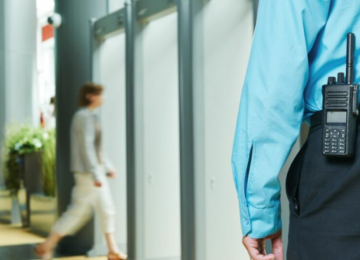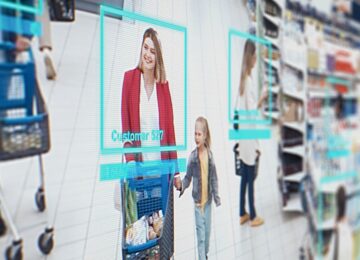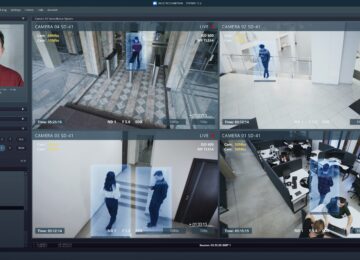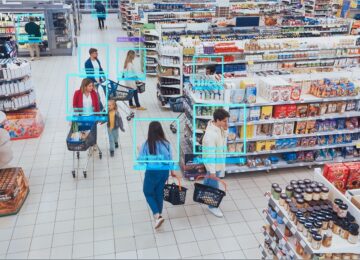How intelligent video surveillance software helps retailers regain control without replacing staff

Retailers are dealing with a simple math problem. Fewer staff on the floor. More theft attempts. Longer hours spent chasing down video footage after the fact.
Intelligent video surveillance software changes that equation by helping store teams focus on customers while still staying on top of risk.
This isn’t about replacing people. It’s about giving overstretched teams a tool that watches for the right moments, flags what matters, and sends it to the right person quickly. The goal is support, not surveillance—peace of mind without adding headcount or ripping out existing systems.
What AI-powered video surveillance software actually does
Most store teams don’t need more screens. They need timely, useful signals. This section explains how intelligent video surveillance software works in plain language and how it fits inside the broader physical security systems retailers already run.
At its core, the system analyzes behavior in real time. Using machine learning and AI-driven analytics, it strengthens situational awareness by looking for gestures and actions that often precede concealment or walkouts.
When the pattern seems suspicious, the software sends a short clip to the app so a human can confirm—the AI spots the pattern. The team decides. Alerts typically arrive in seconds, so response times stay tight and staff can step in without escalating a situation.
Key capabilities retailers rely on today:
- Gesture detection that recognizes concealment behaviors with object detection, motion detection, and AI-powered analytics tuned for busy aisles—supporting early threat detection where it matters most
- Real-time notifications with context—short video footage clips and timestamps pulled from video data, so no one scrubs hours of recordings
- Remote access on iOS, Android, and web so managers can review and act even when offsite
- A user-friendly interface designed for store teams, not engineers
If you’re exploring how retailers are already using cameras to prevent shrinkage and support staff, check out our practical guide on video surveillance in stores.
Why traditional setups can’t keep up with today’s security needs
Teams know this story well. Traditional camera setups ask people to sit and stare at screens.
Most incidents are noticed late, if at all, and investigations mean long nights downloading files and hunting for clips. That approach struggles in a sector where repeat theft is more common and staff are already stretched.
Independent research reflects what store teams describe. U.S. retailers reported a 93% increase in the average number of shoplifting incidents since 2019, along with a 90% increase in dollar losses over the same period, according to the National Retail Federation (NRF) and the Loss Prevention Research Council (LPRC).
In the U.K., the British Retail Consortium (BRC) noted rising incidents of violence and abuse against retail staff in 2023/24, underscoring how fast intervention and safer workflows matter for teams on the floor.
The takeaway is pragmatic. Watching everything all the time isn’t realistic. Retailers need real-time monitoring that surfaces the few moments that matter and fits into day-to-day security operations without slowing down service.
Regaining control with advanced features and real-time insights
A better setup helps teams act sooner and learn faster. This section previews the features retailers use to mitigate risk across stores while staying grounded in real-world operations and staffing limits.
First, timely alerts change the tempo of the day. Instead of scanning 16 feeds, a cashier or security agent gets an alert, reviews a ten-second clip, and decides how to engage. Alerts usually appear within about 30 seconds, which is enough time to step toward the aisle and calmly check on a shopper.
Second, trend and pattern visibility matters. Managers can see which aisles, hours, or product categories trigger the most alerts, spot anomaly detection patterns in behavior, and adjust merchandising, staffing, or signage.
Finally, central oversight is practical. From a single dashboard, a security agent can stay on top of multiple locations—seeing alerts as they happen and coordinating the right response without juggling separate systems.
What helps on the ground:
- An intuitive dashboard with advanced video analytics reporting so leaders prioritize action rather than guess.
- Per-store views that keep accountability clear while still letting one person monitor several sites as needed.
- Comprehensive monitoring that complements existing security solutions and access control systems.
- Seamless integration with legacy systems through standards like RTSP and ONVIF, so retailers don’t have to replace cameras just to get started. Ongoing updates to video surveillance industry standards help ensure different camera systems keep working smoothly together.
For operators evaluating options, it helps to see where this fits alongside video management systems already in place. In many environments, the AI layer sits on top of existing video management software or a scalable video management system, while also supporting cloud-based video surveillance for teams who prefer to access analytics and clips from anywhere.
AI video analytics that empower, not replace, the staff
This point deserves its own moment. Store teams are central. The system is a helper.
As one store team shared after switching from traditional monitoring to AI alerts: “More time to advise customers and less on watching every move of every client.” That change shows up in everyday moments—helping a shopper find a product instead of staring at a screen; walking the floor instead of sitting in a back office.
Another common concern is job security. Early on, some security agents worry about being replaced. As one leader put it, “they are afraid the AI will take over their job,” but over time, they see it as “a smart tool to help them perform better and faster.”
In practical terms, AI narrows attention to key events and reduces fatigue. Cashiers keep their focus. Managers save time on investigations. Security teams get a clearer context to resolve issues safely.
Privacy also counts. Retailers can choose solutions designed with compliance principles in mind and configured to minimize data retention. Risk frameworks from organizations such as NIST offer practical guidance for deploying artificial intelligence responsibly in retail contexts and reinforcing security management practices.
A flexible solution that makes teams feel safer and smarter
The real test of any platform is whether it helps people do their jobs better. Intelligent systems built for security operations should make work feel calmer, not more complicated. That means an intuitive user interface for frontline teams, remote access for leaders, and clear reporting for planning and coaching.
Two examples capture the difference:
- Independent grocer, five lanes: The owner connected the software to existing cameras and trained the team on the mobile app in one shift. Within days, staff reported fewer tense interactions at the front of the store because alerts signaled them to engage early rather than after a walkout. The owner didn’t add staff or new cameras. The change was in awareness and timing.
- Regional manager, 20+ stores: With per-store dashboards, a single agent could rotate across sites—qualifying alerts and only calling stores when needed. This approach could protect margins without adding headcount, while also creating a feedback loop: reports might reveal repeat patterns by hour or aisle, helping guide fixture placement and staffing adjustments for greater efficiency.
To see how intelligent monitoring integrates with existing CCTV setups, explore our overview of retail video surveillance—a practical resource for planning and next steps.
Where it fits in the stack: practical notes for security and IT
Before any rollout, operators and IT teams want to know how intelligent video surveillance software fits the current stack and whether it is future-proof.
Here are straightforward answers aligned to how modern stores run physical security systems:
- Works with what’s installed: Most retail cameras already work with common standards. An open platform helps them connect smoothly with existing video management systems, so stores don’t need to buy new hardware.
- Cloud when it helps: Many retailers prefer a hybrid approach—local recording with cloud-based video surveillance for analytics, alerting, and clip sharing. That balance keeps bandwidth predictable while giving regional leaders remote access from anywhere.
- Built for scale: Larger operators want a scalable video management system and AI layer that can be configured store by store. Role-based access, alert schedules, and per-store reporting make it easy to maintain standards without slowing teams down.
- Keep governance simple: Responsible artificial intelligence deployment follows recognized practices. The NIST AI Risk Management Framework is a credible, noncommercial reference that many enterprises use to structure governance and training.
- Plan for the long run: Industry groups continue to highlight AI’s role in security. The Security Industry Association’s 2024 Megatrends named AI’s visual intelligence among the top drivers of change—evidence that investments here align with where the industry is headed.
For store teams curious about how “smart cameras” fit into daily operations, our guide on the smart camera in retail breaks down practical options and tradeoffs.
What AI-powered video surveillance software actually looks like in daily work
It helps to picture the shift in the flow of a day:
- Real-time monitoring runs quietly in the background. When the system detects a high-risk gesture, it sends a push alert with a short clip.
- A staff member glances at the alert, determines whether it requires action, and walks the floor. Most interactions remain low-key and service-led.
- If needed, the manager saves the clip for documentation. Those clips, along with counts by time and aisle, build a simple incident log that informs scheduling and merchandising.
- A regional manager reviews weekly trends, compares sites, and plans adjustments. Because the AI narrows events from hours of footage to minutes of review, teams capture more signals with less effort.
The net effect is calm control. More presence on the floor. Less time in the back office. Better handoffs between staff. And fewer late-night video pulls when everyone should be home.
What changes for teams after rollout
Based on common feedback from store operators and security agents, several patterns emerge after moving from passive cameras to intelligent alerts:
- More time with customers: Teams shift attention from watching feeds to advising shoppers and maintaining displays.
- Fewer repeat incidents: Early engagement discourages regular offenders who test gaps in coverage.
- Clearer coaching moments: Short clips help managers train staff on when and how to intervene.
- Simpler coordination across sites: One trained agent can rotate through stores and qualify alerts across multiple locations without adding a new console or retraining everyone.
For context, industry bodies continue to document the pressure on retail teams and the need for sustainable approaches. The NRF and LPRC’s work provides U.S. benchmarks on theft trends, while the BRC offers a view from the U.K.—useful for international operators who want comparable signals when building budgets and training plans.
A note on change management and staff buy-in
Any new system brings questions. Security agents often ask whether AI means fewer jobs. The experience in stores has been different.
Per an expert who led a frontline rollout, agents started skeptical, then realized the system was “a smart tool to help them perform better and faster.” That shift happens when leaders show the tool in action, set clear escalation guidelines, and celebrate calm, early interventions—not just apprehensions.
Practical steps that build confidence:
- Train on scenarios, not features: Walk through common aisle events and how to respond.
- Keep the intuitive user interface front and center: Staff should get just what they need: a verified alert, the clip, and clear next steps.
- Assign a “first responder” per shift: Make ownership simple so alerts don’t bounce around.
- Review weekly reports together: Use them for coaching, merchandising moves, and staffing plans.
When training is practical, ownership is clear, and insights are shared, AI stops feeling like another tool to manage and starts becoming a trusted partner. The result is a team that’s calmer, more confident, and ready to act when it matters most.
Quiet upgrades that matter to IT and finance
Operators and CFOs care about the details that make a rollout stick without hidden costs:
- Seamless integration with NVRs and video management software means no new servers in most cases.
- A comprehensive security solution doesn’t mean monolithic. The AI layer complements existing security solutions and entry systems rather than replacing them.
- Deployment can be quick. Remote setup cuts down on store visits, and common standards make it easy to connect different types of cameras quickly.
- The system scales with the business. Add stores and users without re-architecting.
- Operational efficiency gains show up as fewer hours spent scrubbing files and clearer decisions during incidents.
Industry trendlines point in the same direction. AI’s role in security is expanding, not shrinking, according to SIA’s 2024 analysis. Planning for AI in the video surveillance industry now sets retailers up for steadier operations later.
Better together: Human judgment plus intelligent monitoring
Retail teams do their best work face-to-face with customers. Intelligent video surveillance software backs them up by watching for the right moments and delivering alerts on only what matters.
It works with legacy systems, respects privacy, and keeps staff in control; for many operators, that adds up to calmer shifts, smoother security management, and more consistent outcomes across stores.
How might this fit a current CCTV setup or a specific store format? See it in action. Book a demo with Veesion to discover how intelligent video surveillance software can plug into your existing CCTV setup, deliver real-time insights, and give your team more time for customers—not monitors.
Les plus populaires
Nouvelles liées
Découvrez ce que Veesion peut faire pour vous
Vous avez un ou plusieurs magasins ? Notre équipe revient vers vous dans les 48h.






